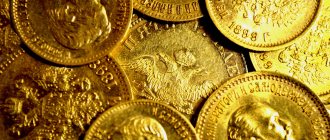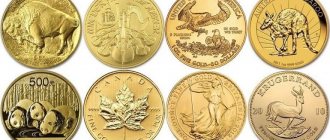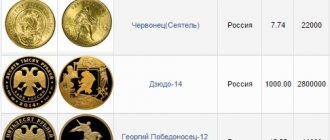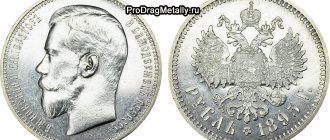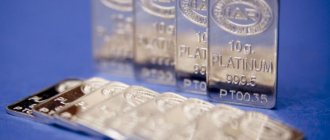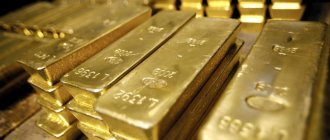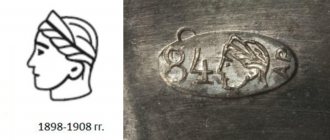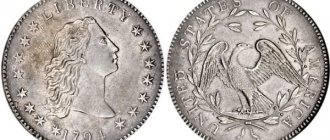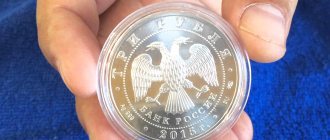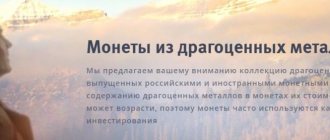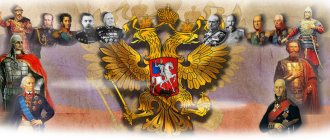Coins of modern Russia with a denomination of 5 kopecks, which were minted en masse from 1997 to 2021, are becoming increasingly difficult to find in circulation. Due to rising prices for goods and services, the need for pennies when conducting monetary transactions has practically disappeared.
Previously minted five-kopeck coins ended up lying unnecessarily in the piggy banks of the population. And it has become impractical to produce new small coins, since issue is more expensive than their face value.
All five-kopeck coins were minted at two enterprises. The Moscow Mint (abbreviated as MMD) puts a miniature letter “M” on kopecks, the St. Petersburg Mint (SPMD) puts the letters “SP”. The mint mark should be found on the obverse under the hoof of the horse's raised foreleg.
Option M:
SP option:
Learn more about mint marks on coins.
Rare pennies from 1997-1998.
During these years, a huge number of coins of all denominations, including penny ones, were circulated. There are no truly rare or expensive coins among them, but if you come across coins from 1997 and 1998 in absolutely perfect condition, you can sell them for 10-50 rubles.
But the coins must have no traces of use at all, and their stamp shine must be the same as it was when the coin was first taken out of the bank bag.
Rare penny coins from 1999.
This year we can already find both uncommon and rare coins. Thus, a coin with a face value of 50 kopecks, issued in 1999 by the St. Petersburg Mint, is considered rare, and in good condition its price reaches 300 rubles. This year's rare penny coin is 5 kopecks, again SPMD. In general, it was initially believed that in 99 5 kopeck coins were not put into circulation at all, not from any of the yards. But in 2003, several pieces of SPMD 5 kopecks were discovered - one of them was sold at auction at a price of 300,000 rubles - while the condition of the coin was not ideal and had significant damage in the form of scratches and even rust.
The most expensive nickels of the Soviet Union
In tsarist times, the five-kopeck denomination either moved to the group of silver coins or returned to copper ones, but in the Soviet period its role remained uniform. It crowned a group of lower denominations, minted first from aluminum bronze and then from brass, but out of habit they were called “copper”. The nickel was a large coin weighing five grams. During the period of the late USSR, it was most often used to enter the metro, because prices were then regulated by the state and did not change for decades. To ensure the monetary turnover of the country, whose population in 1991 was 293,000,000 people, a huge number of five-kopeck coins were required. Most of them are not that expensive now. But even among them there are real rarities for which numismatists are willing to pay well. Let's look at the most expensive of them.
5 kopecks 1924
5 kopecks 1924 in excellent condition
The only Soviet nickel made of copper. By the time the coin was put into circulation, the domestic mint of St. Petersburg, renamed Leningrad, did not have time to mint the required quantity, so part of the circulation was ordered in Great Britain. The total number turned out to be quite large, but after two years the bulky coins, made according to the standards of tsarist times, were replaced by specimens made of aluminum bronze.
What to look for?
If you do not take into account rare varieties, first of all it is worth considering the degree of preservation of the coin. A lot of broken, worn-out, washed-out nickels have survived to our time. Coins in good and excellent preservation are expensive: in stamp shine and without defects. However, when you see such a specimen, you should not immediately grab it at low prices. A galaxy of fakes has been launched, which only experts can identify. Therefore, you should purchase this year’s nickel in exceptional condition only in trusted places.
5 kopecks 1927
Rare 5 kopecks 1927
A year earlier, the transition from copper to aluminum bronze was completed. The nickel decreased in diameter by seven millimeters and became noticeably lighter (from 16.38 grams to five). Apparently, the initial circulation of coins of the new standard was satisfied by the State Bank, so the minting volumes were sharply reduced. The queen of the USSR year collection is a two-kopeck coin with the date “1927”. But a nickel with the same date is rare and desirable. An excellently preserved example of a five-kopeck coin from 1927 is quite comparable in value to the legendary two-kopek coin, extracted from the ground with large flaws.
What to look for?
Basically, to the number “7”. High prices force “masters” to produce overcuts - original coins with a changed date number. If you have the original in your hands, it is worth checking the number of meridians approaching the sharp part of the hammer from above. If there are three of them (the “convex globe” variety), then this coin is valued by lovers of varieties several times higher than two meridians (the “flat globe” variety).
5 kopecks 1933
5 kopecks 1933 (regular copy and mix-up)
It is considered the rarest of the USSR nickels minted in mass circulation. It still remains a mystery why it was minted in such a small volume. An exceptionally rare variety of it is an obverse from the future - a coat of arms without an arc inscription along the edge “Proletarians of all countries, unite!” It is hypothesized that this coin could have been minted in 1935, when the new type of coat of arms already existed and was involved in mass production paired with the reverse, which bore the date “1935.”
What to look for?
On the location of the date and the last three in it. The original nickel has an understated date, which gives away high-quality cuttings. Poor quality cuts are indicated by the number “3”, which is sharply different from the rest. However, if the date looks legitimate, you should take the time to compare the offered copy with the catalog one. There are a lot of coin-shaped products on the market that resemble 5 kopecks from 1933. However, none of them has yet managed to reliably replicate the original.
5 kopecks 1934
Rare 5 kopecks 1934
The coin is quite expensive, although it is noticeably lower in value than the nickel issued a year earlier. Previously, it was one of the rarest five-kopeck coins. Now, so many of them have been collected that a poorly preserved example is available even to novice collectors.
What to look for?
For date and for defects. Despite the fact that the lion's share of counterfeits dates back to 1933, people are also trying to copy these nickels. For original coins, safety is important. A mutilated and worn-out coin is inexpensive, but good preservation takes the price to sky-high heights.
5 kopecks 1935 (old and new coat of arms)
5 kopecks 1935 (with and without inscription)
As you can see from the picture, there are two versions of this coin: with and without an inscription around the coat of arms. However, unlike the mix-up of 1933, both variants were minted en masse. In 1935, a planned transition to a new type of coat of arms took place. And yet the situation is the opposite: much fewer coins with the inscription have survived than without it. The nickel with the new coat of arms has now practically dropped out of the group of rare coins.
What to look for?
Here it will be very informative to look at the catalog and try to understand the varieties. For example, even a nickel with a new coat of arms will pleasantly appreciate its value if on its obverse the upper spine of the middle ear to the left of the star rests on its ray.
5 kopecks 1936-1938
The times when any of these coins were considered rare enough are irrevocably gone. Owners of metal detectors raised a lot of nickels with dates from this period. Offers on the market have increased sharply. However, they still cost higher than the nickels of 1930-1932.
What to look for?
For the degree of preservation. It is easy to buy an “earthen” copy with flaws, but the supply of “cabinet” preserved coins on the numismatic market is quite limited.
5 kopecks 1945
Uncommon 5 kopecks 1945
During the difficult years of the war, five-kopeck coins with the dates “1942” and “1944” were not minted at all, and the circulation of the victorious year was not so large. Therefore, copies without defects are expensive.
What to look for?
Again, on the degree of preservation. It is now almost impossible to attach a coin, where a rare date is vaguely visible on a corroded field. Everyone wants to put a decent quality nickel in an album.
5 kopecks 1947
Demonstration copy with traces of soldering on the obverse
The planned monetary reform was accompanied by explanatory work, which included stands where the banknote and coin series of future money were presented. For this purpose, a special batch of coins was minted and attached to display stands either with the obverse or the reverse. The prepared mass circulation was completely destroyed for unknown reasons.
What to look for?
For all! Demonstration coins are incredibly rare. But the market is simply flooded with their copies, quite similar to the original, if you don’t look closely. However, a comparative analysis of the pictures of the original and coin-shaped products will certainly reveal the differences between the latter. Solder marks are not a guarantee of authenticity. In addition, there are originals that have escaped placement on display stands.
5 kopecks 1958
Very rare 5 kopecks 1958
Another representative of the destroyed circulation, prepared for the failed reform of 1958. Despite their great rarity, these nickels are much easier to acquire than those with the date “1947”. Bags of coins distributed to savings banks were confiscated, but in isolated cases, when there was a shortage of small change coins, brand new nickels were sent into circulation contrary to instructions.
What to look for?
On the date. Various sites are full of offers of cuttings, where a “rarity” is made from a coin of later years by replacing the third digit with “5”. However, the details of the design of the 1958 specimen have features that allow numismatists to easily weed out fakes intended for beginners.
5 kopecks 1965, 1966, 1969, 1971, 1972
Reverses of rare coins
Having minted a sufficient number of nickels in the early 60s, the State Bank stopped their production for two years, and then continued minting in much smaller volumes. Nickels with these dates were almost impossible to catch in circulation even during the Soviet era. Now each of these coins is rare and expensive.
What to look for?
First of all, it is worth weeding out the “intersections”. For originals, it is worth paying attention to the quality of the coinage. There are both circulating coins on the market and examples taken from sets. With the same degree of preservation, collectors value set coins lower.
5 kopecks 1967 and 1968
5 kopecks 1967 (left) and 1968 (right)
During these two years, the volume of minting increased slightly, but not enough for these coins to be found in circulation as often as ordinary ones.
What to look for?
It’s also worth checking whether the copy you have is a typed copy or a working one. Why are set coins a little cheaper? Because not all collectors buy them. Some of them do not consider set coins to be “real”, since they were not minted for circulation. However, both set and circulating copies are real coins (if their authenticity is confirmed).
5 kopecks 1970
Rare 5 kopecks 1970
Here is the rarest of the post-reform five-kopeck coins. Experts say that its circulation is not millions or billions, but several tens of thousands. It is not surprising that it stands out sharply in price among other nickels. It is also not surprising that people most often seek to counterfeit it.
What to look for?
For authenticity. The most dangerous are the cuts from 1976, where the reverse design practically coincides with the reverse of the rare year. However, the “masters” have not yet succeeded in depicting a perfect “0” and cutting it into the coin field without shifting.
5 kopecks 1990 M
5 kopecks 1990 with the designation MD
An expensive example of the late USSR owes its appearance to the mint letter on the obverse, planned since 1991. However, on the MMD they paired the old reverse with the date “1990” with the new obverse, where the letter already appeared. Despite the fact that this nickel is a classic mix-up, it has its own position in price tags, since the presence or absence of a mint mark is an important feature of any coin.
What to look for?
First of all, reverse. If previously it was incredibly difficult to accurately embed the letter “M” into the field of a coin, modern technologies provide such an opportunity. But “masters” who are unfamiliar with the peculiarities of coins sometimes take as a blank an ordinary coin from 1990, not MMD, but LMD, which differs in the reverse design. Secondly (when the reverse of the MMD is confirmed), we study the letter “M”, comparing its lines and location with the coin from the catalog. Only this will prevent you from buying a fake instead of the original, to the detriment of collectors.
Here is a summary of all the expensive five-kopeck coins of the Soviet Union, which can be quickly distinguished from a pile of ordinary ones, without going into the small details of the design (varieties). We hope that our tips will help you avoid disappointment and not miss a rare coin when it appears on your horizon.
Very rare coin 50 kopecks 2001
You will not find a 50 kopeck coin from 2001 in circulation. However, if by luck you are the owner of the 2002 MMD annual set, then you may be incredibly lucky. The fact is that the first edition of the 2002 sets included coins from 2001, including 50 kopecks from 2001. Currently, its cost has already exceeded half a million rubles. In this regard, there are many fakes on the market. They make fake 50 kopecks from 2001 from coins from 2004 or 2007 by changing the last dating digit.
The remaining penny coins of 2001 are not rare and do not have numismatic value.
Valuable varieties
Despite their external similarity, coins of the same year of issue often have slight differences. Thus, some banknotes may have a slightly shifted letter indicating the mint, while others may have one of the buds without a border. Coins of the same year and from the same mint, but having features, are called varieties. Some varieties are widespread, but there are those that are very rare, in which case their price reaches 10-20 thousand rubles.
For example, Moscow fifty-kopeck coins issued in 2002 may have three options for the position of the letter “M”. The variant with the letter lowered and turned counterclockwise is very rare, its cost is about 15 thousand rubles. The photo shows the differences between the varieties (the expensive variety is designated “piece B”):
If you are ready to devote yourself to searching for expensive varieties, then pay attention to the releases of the following years: 2003, 2004, 2005, 2008, 2010.
All pennies of 2011 SPMD
Officially, in 2011, the denominations of all kopeck coins were minted only in Moscow, but after a while, namely in September 2013, information about the existence of St. Petersburg kopecks appeared on the Internet. It turned out that there is the whole set:
- 1 kopeck 2011 SPMD
- 5 kopecks 2011 SPMD
- 10 kopecks 2011 SPMD
- 50 kopecks 2011 SPMD
All 4 coins were immediately cataloged as rare coins. Their prices start from 300,000 rubles and above. It is not known for certain whether these are test coins or piece products made to order (ordered), but there is no doubt that they were minted at the St. Petersburg Mint.
